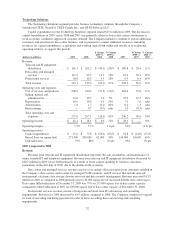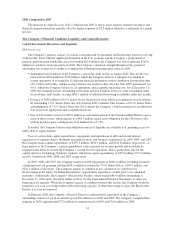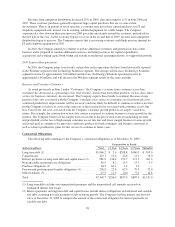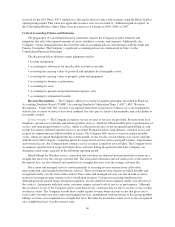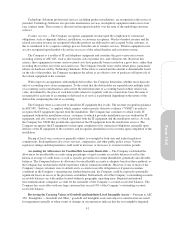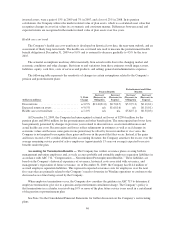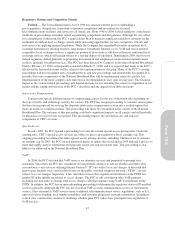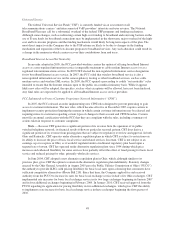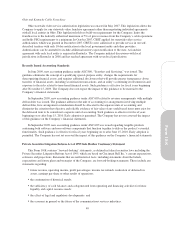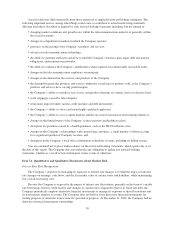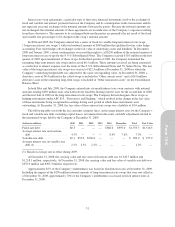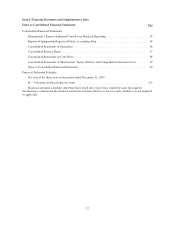Cincinnati Bell 2009 Annual Report Download - page 112
Download and view the complete annual report
Please find page 112 of the 2009 Cincinnati Bell annual report below. You can navigate through the pages in the report by either clicking on the pages listed below, or by using the keyword search tool below to find specific information within the annual report.With respect to goodwill, the Company estimates the fair value of the respective reporting unit based on
expected future cash flows generated by the reporting unit discounted at the appropriate weighted average cost of
capital. The estimated fair value of the respective reporting units was substantially higher than its carrying
values, and, as such, there was no indication of impairment in 2009.
Indefinite-lived intangible assets consist of FCC licenses for spectrum and trademarks for the Wireless
segment. The Company may renew the wireless licenses in a routine manner every ten years for a nominal fee,
provided the Company continues to meet the service and geographic coverage provisions required by the FCC.
The fair value of the licenses was determined by using the “Greenfield” method, an income-based approach. The
fair value of the trademarks was determined by using the relief-from-royalty method, which estimates the present
value of royalty expense that could be avoided in the operating business as a result of owning the respective asset
or technology. The fair values of the licenses and trademarks were at least 30% higher than their respective
carrying values, and, as such, there was no indication of impairment in 2009.
Changes in certain assumptions could have a significant impact on the impairment test for goodwill and
indefinite-lived intangible assets. For example, a one percent change in the discount rate used to determine the
fair value of the Wireless segment, which represents over 80% of the Company’s total goodwill and indefinite-
lived intangible assets, would result in a change in the fair value of this reporting unit by approximately $40
million.
Reviewing the Carrying Values of Property, Plant and Equipment — The Company’s provision for
depreciation of its telephone plant is determined on a straight-line basis using the group depreciation method.
Provision for depreciation of other property, other than leasehold improvements, is based on the straight-line
method over the estimated economic useful life. Depreciation of leasehold improvements is based on a straight-
line method over the lesser of the economic useful life or term of the lease, including option renewal periods if
renewal of the lease is reasonably assured. Repairs and maintenance expense items are charged to expense as
incurred.
The Company estimates the useful lives of plant and equipment in order to determine the amount of
depreciation expense to be recorded during any reporting period. The majority of the Wireline segment plant and
equipment is depreciated using the group method, which develops a depreciation rate annually based on the
average useful life of a specific group of assets rather than for each individual asset as would be utilized under
the unit method. The estimated life of the group changes as the composition of the group of assets and their
related lives change. Such estimated life of the group is based on historical experience with similar assets, as well
as taking into account anticipated technological or other changes.
The Company reviews the carrying value of long-lived assets, other than goodwill and indefinite-lived
intangible assets discussed above, when events or changes in circumstances indicate that the carrying amount of
the assets may not be recoverable. In assessing impairments, the Company follows the provisions of ASC 360,
“Property, Plant, and Equipment.” An impairment loss is recognized when the estimated future undiscounted
cash flows expected to result from the use of an asset (or group of assets) and its eventual disposition are less
than its carrying amount. An impairment loss is measured as the amount by which the asset’s carrying value
exceeds its estimated fair value.
If technological changes were to occur more rapidly than anticipated, the useful lives assigned to these
assets may need to be shortened, resulting in the recognition of increased depreciation expense in future periods.
Likewise, if the anticipated technological or other changes occur more slowly than expected, the life of the group
could be extended based on the life assigned to new assets added to the group. This could result in a reduction of
depreciation expense in future periods. Competition from new or more cost effective technologies could affect
the Company’s ability to generate cash flow from its network-based services. This competition could ultimately
result in an impairment of certain of the Company’s tangible or intangible assets. This could have a substantial
impact on the operating results of the Company. A one-year change in the useful life of these assets would
increase or decrease annual depreciation expense by approximately $20 million.
Accounting for Business Combinations — In accounting for business combinations, the Company applies
the accounting requirements of ASC 805, “Business Combinations,” which requires the recording of net assets of
acquired businesses at fair value. In developing estimates of fair value of acquired assets and assumed liabilities,
42


